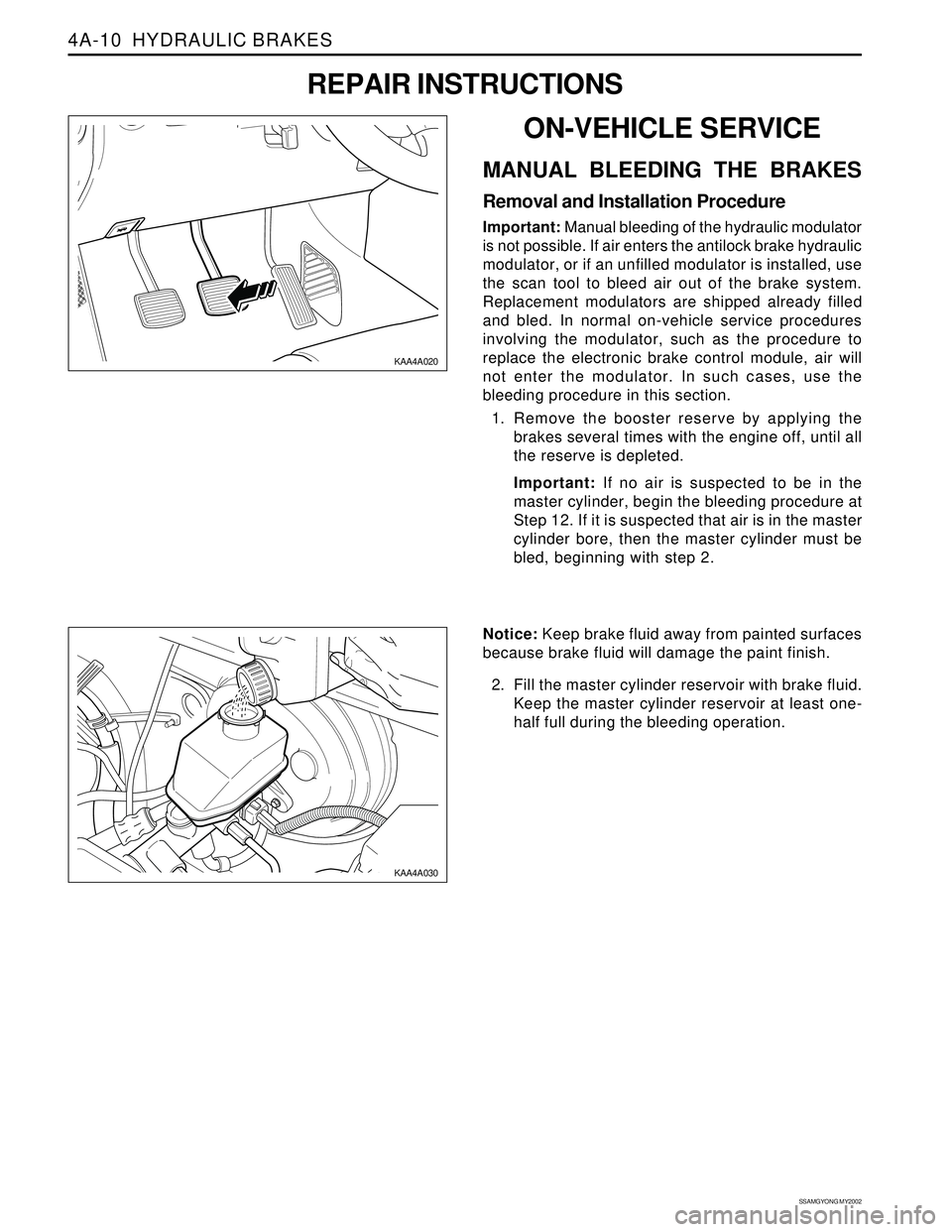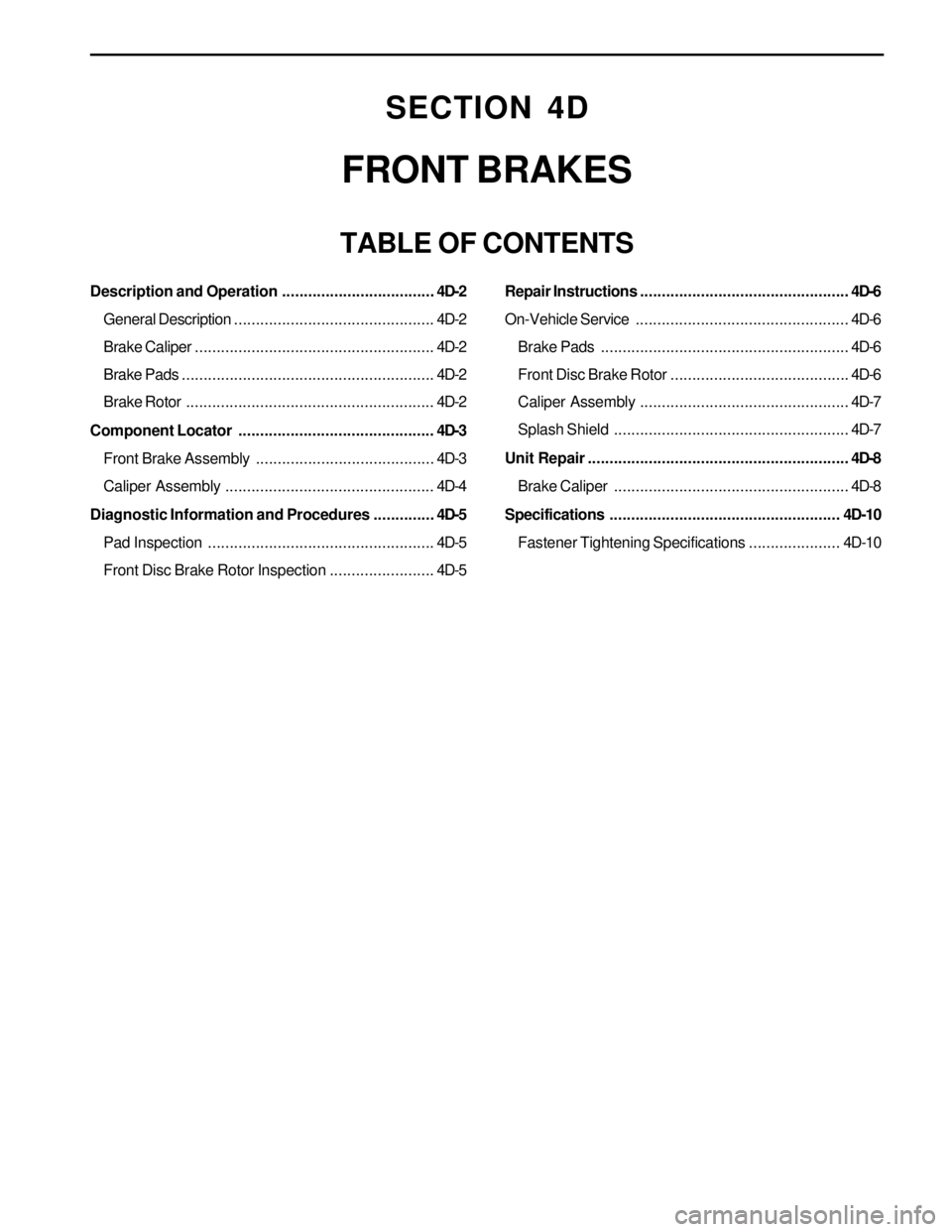section 2c SSANGYONG KORANDO 1997 Service Manual PDF
[x] Cancel search | Manufacturer: SSANGYONG, Model Year: 1997, Model line: KORANDO, Model: SSANGYONG KORANDO 1997Pages: 2053, PDF Size: 88.33 MB
Page 930 of 2053

SSAMGYONG MY2002
4A-10 HYDRAULIC BRAKES
KAA4A020
KAA4A030
Notice: Keep brake fluid away from painted surfaces
because brake fluid will damage the paint finish.
2. Fill the master cylinder reservoir with brake fluid.
Keep the master cylinder reservoir at least one-
half full during the bleeding operation.
ON-VEHICLE SERVICE
MANUAL BLEEDING THE BRAKES
Removal and Installation Procedure
Important: Manual bleeding of the hydraulic modulator
is not possible. If air enters the antilock brake hydraulic
modulator, or if an unfilled modulator is installed, use
the scan tool to bleed air out of the brake system.
Replacement modulators are shipped already filled
and bled. In normal on-vehicle service procedures
involving the modulator, such as the procedure to
replace the electronic brake control module, air will
not enter the modulator. In such cases, use the
bleeding procedure in this section.
1. Remove the booster reserve by applying the
brakes several times with the engine off, until all
the reserve is depleted.
Important: If no air is suspected to be in the
master cylinder, begin the bleeding procedure at
Step 12. If it is suspected that air is in the master
cylinder bore, then the master cylinder must be
bled, beginning with step 2.
REPAIR INSTRUCTIONS
Page 933 of 2053

HYDRAULIC BRAKES 4A-13
SSANGYONG MY2002
Tightening Torque 17 Nm (13 lb-ft)
FRONT BRAKE HOSE
Removal and Installation Procedure
1. Raise and suitably support the vehicle.
2. Disconnect the brake line from the brake hose sup
port bracket on the front frame on each side of the
vehicle and remove the retainer.
Installation Notice
KAA4A080
KAA4A090
KAA4A100
KAA4A110
3. Remove the brake hose from the brake hose
support bracket on the upper control arm.
4. Remove the front brake hose-to-front caliper
assembly bolt.
5. Remove the ring seals and the disc brake hose.
Installation Notice
Tightening Torque 30 Nm (22 lb-ft)
Bleed the brake system. Refer to “Manual
Bleeding the Brakes” in this section.
Check the brake system for leaks.
6. Installation should follow the removal procedure
in the reverse order.
REAR BRAKE HOSE
Removal and Installation Procedure
1. Raise and suitably support the vehicle.
2. Disconnect the brake line from the disc brake hose
at the rear axle bracket on each side of the vehicle.
Installation Notice
Tightening Torque 17 Nm (13 lb-ft)
Page 934 of 2053

SSAMGYONG MY2002
4A-14 HYDRAULIC BRAKES
KAA4A120
KAA4A130
KAA4A140
STOPLAMP SWITCH
Removal and Installation Procedure
1. Remove the stoplamp switch connector.
2. Remove the stoplamp switch.
3. Installation should follow the removal procedure
in the reverse order.
BRAKE PEDAL
Removal and Installation Procedure
1. Remove the stoplamp switch connector.
2. Remove the clevis pin and disconnect the brake
booster pushrod.
Installation Notice:
Install in the upper hole.
Install the snap pin fully in the hole of clevis
pin.
Apply the grease around the hold of clevis pin.
3. Remove the brake pedal mounting nut and remove
the brake pedal assembly.
Installation Notice
Tightening Torque 13 Nm (10 lb-ft)
4. Installation should follow the removal procedure
in the reverse order.
KAA4A070
3. Remove the rear bleeder valve from the caliper as
sembly.
Installation Notice
Tightening Torque 10 Nm (89 lb-ft)
Bleed the brake system. Refer to “Manual
Bleeding the Brakes” in this section.
Check the brake system for leaks.
4. Installation should follow the removal procedure in
the reverse order.
Page 937 of 2053

Description and Operation...................................4B-2
General Description.............................................4B-2
Component Locator.............................................4B-3
Repair Instructions................................................4B-4
On-Vehicle Service.................................................4B-4Brake Oil Level Switch .........................................4B-4
Brake Fluid Reservoir ...........................................4B-4
Master Cylinder...................................................4B-5
Specifications.......................................................4B-8
Fastener Tightening Specifications.......................4B-8
SECTION 4B
MASTER CYLINDER
TABLE OF CONTENTS
Page 938 of 2053

SSANGYONG MY2002
4B-2 MASTER CYLINDER
DESCRIPTION AND OPERATION
GENERAL DESCRIPTION
The master cylinder is designed for use in a parallel
split system. One front and one parallel to rear brakes
are served by the primary piston. The opposite front
and rear brakes are served by the secondary piston.
The master cylinder incorporates the functions of the
standard dual master cylinder, plus a low fluid level
indicator. The brake fluid level switch is attached under
the body of the plastic brake master cylinder reservoir.
Notice: Do not use lubricated shop air on the brake
parts, because oil will damage the rubber components.Important:•Replace all the components included in the repair
kits used to service the master cylinder.
Lubricate the rubber parts with clean brake fluid to
ease assembly.
If any hydraulic component is removed or discon-
nected, it may be necessary to bleed all or part of
the brake system. Refer to Section 4F, Antilock
Brake System and Traction Control System.
The torque values specified are for dry, unlubricated
fasteners.
Perform all service operations on a clean bench,
free from all traces of mineral oil.
Page 941 of 2053

MASTER CYLINDER 4B-5
SSANGYONG MY2002
KAA4B060
4. Remove and discard the brake fluid reservoir seals
from the master cylinder body.
Installation Notice:
Lubricate the new brake fluid reservoir seals with
clean brake fluid.
After the installation, bleed the brake system.
Refer to Section 4F, Antilock Brake System and
Traction Control System.
5. Installation should follow the removal procedure
in the reverse order.
YAD4A340
YAD4A350
YAD4A360
3. Remove the master cylinder.
Retain the master cylinder in the vice and
remove the retainer ring from the master cylinder
using the snap ring plier. 2. Loosen the mounting nut of the master cylinder
and remove the master cylinder from the power
booster.
MASTER CYLINDER
Removal Procedure
1. Disconnect the brake lines from the master
cylinder.
Notice: The brake fluid may damage paintwork, if
spillage onto paintwork, wash with cold water
immediately.
Page 944 of 2053

Description and Operation....................................4C-2
General Description..............................................4C-2
Component Locator..............................................4C-3
Diagnostic Information and Procedures...............4C-4
Power Booster Functional Check..........................4C-4
Repair Instructions................................................4C-5On-Vehicle Service.................................................4C-5
Power Booster Assembly.....................................4C-5
Vacuum Hose......................................................4C-6
Specifications.......................................................4C-7
General Specification ...........................................4C-7
Fastener Tightening Specifications.......................4C-7
SECTION 4C
POWER BOOSTER
TABLE OF CONTENTS
Page 945 of 2053

SSANGYONG MY2002
4C-2 POWER BOOSTER
DESCRIPTION AND OPERATION
GENERAL DESCRIPTION
The power booster is a double-diaphragm, vacuum-sus
pended unit. In normal operating mode, with the service
brakes in the release position, a vacuum-suspended
booster operates with a vacuum on both sides of its
diaphragm. When the brakes are applied, air at
atmospheric pressure is admitted to one side of the
diaphragm to provide the power assist.When the brakes are released, atmospheric air is shut
off from that side of the diaphragm. The air is then
drawn from the booster through the vacuum check
valve by the vacuum source.
Important: If any hydraulic component is removed or
disconnected, it may be necessary to bleed all or part
of the brake system. Refer to Section 4F, Antilock
Brake System and Traction Control System.
Page 948 of 2053

POWER BOOSTER 4C-5
SSANGYONG MY2002
REPAIR INSTRUCTIONS
KAA4C030
KAA4A040
KAA4C050
ON-VEHICLE SERVICE
POWER BOOSTER ASSEMBLY
Removal and Installation Procedure
1. Remove the master cylinder. Refer to Section 4B,
Master Cylinder.
2. Remove the vacuum hose from the booster.
3. Remove the clevis pin and disconnect the pedal
and brake booster push rod.
Installation Notice:
•Apply the grease around the hole of clevis pin.
4. Remove the power booster mounting nuts and re-
move the booster from the dash panel.
Installation Notice
Tightening Torque 17 Nm (13 lb-ft)
Install the new gasket.
5. Installation should follow the removal procedure
in the reverse order.
Page 951 of 2053

Description and Operation...................................4D-2
General Description..............................................4D-2
Brake Caliper.......................................................4D-2
Brake Pads..........................................................4D-2
Brake Rotor.........................................................4D-2
Component Locator.............................................4D-3
Front Brake Assembly.........................................4D-3
Caliper Assembly................................................4D-4
Diagnostic Information and Procedures..............4D-5
Pad Inspection....................................................4D-5
Front Disc Brake Rotor Inspection........................4D-5Repair Instructions................................................4D-6
On-Vehicle Service.................................................4D-6
Brake Pads.........................................................4D-6
Front Disc Brake Rotor .........................................4D-6
Caliper Assembly................................................4D-7
Splash Shield......................................................4D-7
Unit Repair............................................................4D-8
Brake Caliper......................................................4D-8
Specifications.....................................................4D-10
Fastener Tightening Specifications.....................4D-10
SECTION 4D
FRONT BRAKES
TABLE OF CONTENTS